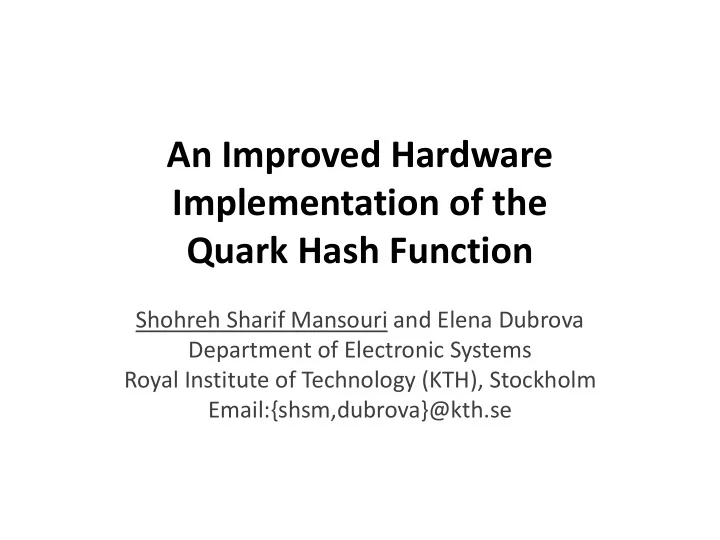

An Improved Hardware Implementation of the Quark Hash Function Shohreh Sharif Mansouri and Elena Dubrova Department of Electronic Systems Royal Institute of Technology (KTH), Stockholm Email:{shsm,dubrova}@kth.se
Overview • Motivation • Structure of the Quark hash function • Techniques to improve implementation • Experimental results • Conclusion 2
The Main Goal • Improving Quark in terms of Throughput , Area and Power • We achieve it by modifying the architecture of Quark without changing its algorithm • We succeed to increase the throughput by 34% for U-Quark 3
Quark Family of Hash Function • Quark is a family of cryptographic sponge functions • Targets resource-constrained hardware environments • Three Quark instances: U- Quark , D-Quark and S- Quark • Supports at least 64-bits, 80-bits and 112-bits security level against most crypto-attacks. 4
Sponge Construction A sponge construction goes through three phases: • Initialization Absorbing phase Squeezing phase Initial value(b bits) S(0) S(1) S(2) . c bits . . r bits S(b-2) S(b-1) output output output block 1 block 2 block 3 5 Message bits
Quark Hardware Structure • The sponge construction can be implemented serially, with a single permutation block. • The permutation block of Quark is based on shift registers • It is inspired by: stream cipher Grain Message (r bits) block cipher KATAN Output stream (r bits) 6
How to Improve Throughput? • Throughput is determined by the critical path, which is the longest combinational path in the system. • Quark ‘s critical: – Dhn : maximal delay from a flip-flop of one of the NLFSRs through the h functions to the first flip-flop of one of the NLFSRs Fibonacci-to-Galois transformation of the FSRs Re-designing H block 7
Fibonacci to Galois Transformation • Improves the critical path delay • Brings no area or power penalty 8
Fibonacci to Galois Transformation* Galois Configuration Fibonacci Configuration 2 delay=3 1 delay=3 delay=3 2 1 delay=5 Critical delay=3 Critical delay=5 f3=x0 + x1x3 f3=x0 + x1x3 +x1x2 f2=x3 +x0x1 f2=x3 f1=x2 f1=x2 f0=x1 f0=x1 *A Transformation from the Fibonacci to the Galois NLFSRs", E. Dubrova,IEEE Transactions on Information Theory , 55:11, 2009, pp. 5263-5271 9
Example The transformation from Fibonacci to Galois is not unique f 3 = x 1 x 2 + x 0 f 3 = x 0 f 3 = x 1 x 2 + x 1 x 3 + x 0 f 2 = x 3 + x 0 x 2 f 2 = x 3 + x 0 x 1 + x 0 x 2 f 2 = x 3 f 1 = x 2 f 1 = x 2 f 1 = x 2 f 0 = x 1 f 0 = x 1 f 0 = x 1 10
Fibonacci to Galois Transformation • Explore the design space to find the best Galois NLFSR equivalent to a given Fibonacci NLFSR • Optimal algorithm: synthesize every possible combination and find the best solution Computationally unfeasible - we need a heuristic approach* F2G: http://web.it.kth.se/~dubrova/fib2gal.html *"An Algorithm for Constructing a Fastest Galois NLFSR Generating a Given Sequence”, J.-M.,Chabloz, S. Mansouri, E. Dubrova , in Sequences and Their Applications , LNCS 6338, 2010, pp. 41-55 11
Loading • Sometimes, with the same initial values, Fibonacci and Galois FSRs may produce different output streams. 1 0 0 1 0 0 1 0 0 1 Not same output stream 12
Loading • The Fibonacci FSR and the Galois FSR are loaded in parallel with the same value • Update functions of the Galois FSR are "turned on" one by one 13
1 0 0 1 same output stream 14
Re-designing the Filter Generator Critical path x n-1 = x 0 + g n-1 + h x n-2 = x n-1 + g n-2 x n-3 = x n-2 + g n-3 x n-4 = x n-3 ... ... h = x 2 + x 8 x 12 + x 13 x 20 x 0 = x 1 Possible critical path x n-1 = x 0 + g n-1 + h n-1 x n-2 = x n-1 + g n-2 + h n-2 x n-3 = x n-2 + g n-3 + h n-3 x n-4 = x n-3 ... x 11 x 18 ... x 7 x 11 x 2 x 0 = x 1 15
Implementation Results for U-Quark • Throughput improvement: 34% • Power improvement: 15% • Area overhead is less than 1% 16
Other Achieved Improvements • We improved the hardware implementation of some FSR based stream cipher. • The best achieved improvements are for Grain-80, Grain-128 and Grain-128a. Grain-128a* Grain-128** Grain-80** Quark Freq. 52% 47% 42% 34% Area -5% 6% 5% -1% Power 2% 9% 11% 15% *"An Improved Hardware Implementation of the Grain Stream Cipher", S. Mansouri, E. Dubrova in Euromicro Conference on Digital System Design (DSD’2010) ** "An Improved Hardware Implementation of the Grain-128a Stream Cipher", S. Mansouri, E. Dubrova , in International 17 Conference on Information Security and Cryptology (ICISC’2012)
Conclusion • High throughput improvement • Limited area/power impact • Techniques compatible with the standard ASIC flow • Some techniques can be applied to other ciphers 18
Thank You for your attention Questions? F2G: http://web.it.kth.se/~dubrova/fib2gal.html
Feedback 1 0 0 1 Start wth different initial value same output stream 20
Recommend
More recommend